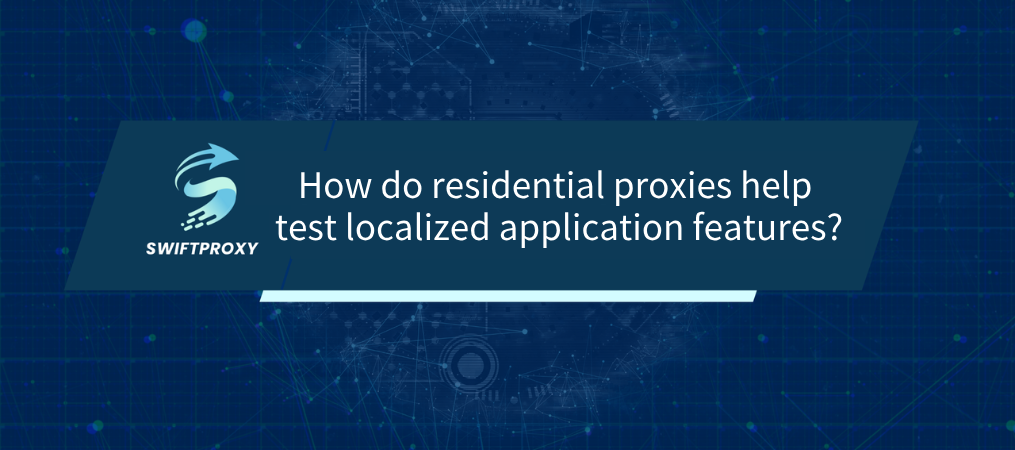How do residential proxies help test localized application features?

In order to ensure that users in different countries and regions can get a good user experience, developers need to test localized applications. In this process, residential proxies play a vital role. This article will detail how residential proxies can help test localized application features.
What is localized application testing?
Localized application testing is the process of ensuring that software is adapted to a specific region, language or cultural environment. It aims to verify the accuracy of content, the adaptability of design, and the effectiveness of functions to meet local user expectations and standards.
It mainly includes the following areas of testing:
- Language verification : Check the accuracy, naturalness and contextual adaptability of translations.
- Interface and design : Evaluate layout, text alignment and character encoding issues to ensure visual appeal and functionality.
- Cultural adaptability : Confirm whether cultural elements such as symbols, colors and images are appropriate to avoid offending or confusing users.
- Functional review : Check the correctness of regional specific functions such as date format, time zone, currency symbol, etc.
Localization testing is essential to ensure the success of software products in the global market. It helps to build trust, improve usability, and improve the overall satisfaction of international users.
What are the challenges of localization testing?
The challenges of localization testing mainly include the following points:
- Text length and layout: The text length of different languages may cause layout problems, such as text overflow or misalignment, and dynamic layout needs to be used to adapt to different language lengths.
- Date, time and currency format: Different regions use different date, time and currency formats, and it is necessary to ensure that the application can display and handle these formats correctly.
- Translation accuracy: Translation errors may cause the application to be misunderstood, and a professional translation team needs to be hired and the translation quality needs to be ensured.
- Region-specific functions and regulations: It is necessary to ensure that the application meets local functional requirements and regulatory requirements, such as geolocation services, privacy policies, etc..
- Context and Chinese character ambiguity: In Chinese localization, context is crucial to translation, and Chinese characters have multiple meanings, requiring translators to have creative translation capabilities.
- Requirement omission and emotional issues: Requirements may be omitted during the localization process, and the large amount of initial verification work is prone to emotional problems.
These challenges need to be fully valued and addressed in localization testing to ensure the success of the application in the global market.
The role and advantages of residential proxies
Residential proxies are network tools that can simulate real user network environments and provide IP addresses in different geographical locations. When testing localized applications, using residential proxies has the following advantages:
- Simulate real user environments: The IP addresses provided by residential proxies are derived from real residential networks and can simulate user network environments in different countries and regions, thereby more realistically reflecting the compatibility and performance of applications in different regions.
- Break through geographical restrictions: The functions and services of many applications are restricted by geographical location. Using residential proxies, developers can easily break through these restrictions and test the availability and functional integrity of applications in different regions.
- Improve testing efficiency: With residential proxies, developers can test localized applications in multiple regions at the same time without having to switch frequently between different regions, which greatly improves testing efficiency.
Specific application scenarios of residential proxies in the testing process
Language and cultural testing
Using residential proxies, developers can test the performance of applications in different languages and cultural contexts. For example, test whether the interface display, text translation, and date format of applications in different language environments are in line with the habits of local users.
Payment and currency testing
For applications involving payment functions, developers can use residential proxies to test payment methods and currency formats in different countries and regions. This helps ensure that the application can correctly process and display transaction information in different currency units.
Legal and compliance testing
Different regions may have different laws, regulations, and privacy policy requirements. Using residential proxies, developers can test the legal and compliance performance of applications in different regions to ensure that the application complies with local laws and regulations.
How to test with a residential proxy
1. Get a residential proxy
Sign up and log in to Swiftproxy to get a residential proxy.
2. Configure proxy settings
Configure residential proxy settings in the development environment. This usually includes setting the address, port, and authentication information of the proxy server.
3. Start testing
Start localized application testing with configured proxy settings. Ensure that network resources and services in the target region can be properly accessed during testing.
4. Collect and analyze test results
During testing, collect and analyze application compatibility and performance data in different regions. Optimize and improve the application based on the test results.
Conclusion
Residential proxies play an important role in localized application testing. By providing IP addresses in different geographical locations and simulating real user network environments, residential proxies help developers more realistically reflect the compatibility and performance of applications in different regions, thereby improving testing efficiency and accuracy. When conducting localized application testing, developers should make full use of the advantages and functions of residential proxies to ensure that applications can provide a high-quality user experience worldwide.

















































